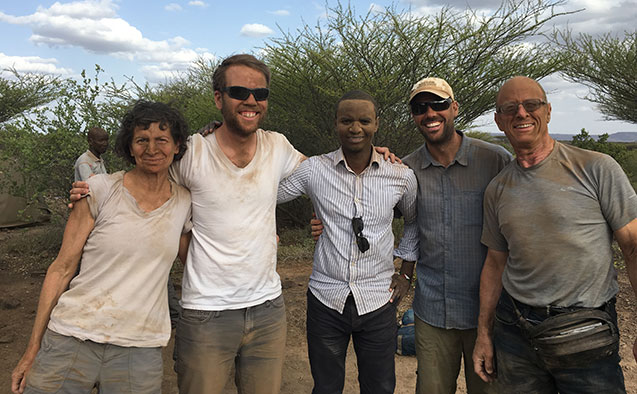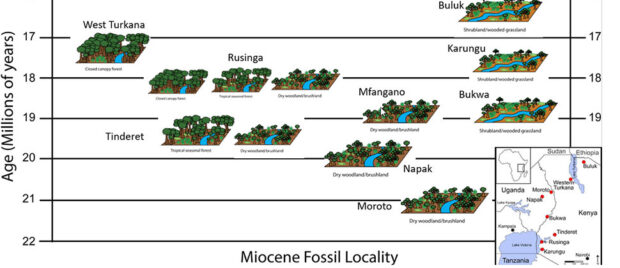Wake Forest anthropologist collaborates on project that shifts a paradigm of ape evolution

At Buluk, an ancient fossil site in remote northern Kenya, Wake Forest University paleoanthropologist Ellen Miller uncovered clues about the habitats of apes living there 16 million years ago.
Miller, who studies the fossil evidence for primate evolution, is part of a collaborative team of geologists and paleoanthropologists led by Baylor University professor Daniel Peppe, Ph.D. Their work, published in the journal Science this week, documents the earliest evidence for locally abundant C4 grasses in eastern Africa and how grasses and open habitats influenced early ape evolution.
The geologists working with Miller found that grasses grew at the Buluk site during the Early Miocene, and shared the data with those doing field work at eight other fossil sites in the East African Rift of Kenya and Uganda. The Buluk site is the easternmost of all the known fossil localities, so she was able to provide data from the far reaches of early ape’s adaptive range.
“When we pooled the data from all of our sites the picture became clear,” said Miller, one of several co-authors on the study. “Grass was abundant at all of our localities.
“The combined data pushes back the presence of grassy habitats in Africa by over 10 million years, and overturned the previous paradigm, that our ape ancestors evolved in more closed forest habitats.” Ellen Miller, professor of anthropology
Collectively known as the Research on Eastern African Catarrhine and Hominoid Evolution project or REACHE, the team simultaneously focused on understanding the types of ecosystems that existed in the Early Miocene, and particularly the prevalence of open environments and C4 grasses, and how these different environments could have potentially affected the evolution of early apes.
The research flourished through the uniqueness of the REACHE collaboration, according to co-author, Kieran McNulty, Ph.D., professor of anthropology at the University of Minnesota who played a central role in organizing the project.

The result of this decade-long research pushes back the oldest evidence of C4 grass-dominated habitats in Africa, calling for revised palaeoecological interpretations of the development of plants and mammals.
“We suspected that we would find C4 plants at some sites, but we didn’t expect to find them at as many sites as we did, and in such high abundance,“ Peppe said. “Multiple lines of evidence show that C4 grasses and open habitats were important parts of the Early Miocene landscape and that early apes lived in a wide variety of habitats, ranging from closed canopy forests to open habitats like scrublands and wooded grasslands with C4grasses. It really changes our understanding of what ecosystems looked like when the modern African plant and animal community was evolving.”
A critical aspect of this work was that the team combined many different lines of evidence together: geology, fossil soils, isotopes and phytoliths, which are plant silica microfossils, to reach their conclusions.
“Taken together, the pattern tells us that there was great habitat heterogeneity during the Early Miocene, ranging from closed forests to wooded grasslands,” Miller said.
The work was funded by the National Science Foundation.
ABOUT THE AUTHORS
In addition to Daniel J. Peppe, the research team includes Susanne M. Cote, Alan L. Deino, David L. Fox, John D. Kingston, Rahab N. Kinyanjui, William E. Lukens, Laura M. MacLatchy, Alice Novello, Caroline A.E. Strömberg, Steven G. Driese, Nicole D. Garrett, Kayla R. Hillis, Bonnie F. Jacobs, Kirsten E.H. Jenkins, Robert Kityo, Thomas Lehmann, Fredrick K. Manthi, Emma N. Mbua, Lauren A. Michel, Ellen R. Miller, Amon A.T. Mugume, Samuel N. Muteti, Isaiah O. Nengo, Kennedy O. Oginga, Samuel R. Phelps, Pratigya Polissar, James B. Rossie, Nancy J. Stevens, Kevin T. Uno and Kieran P. McNulty.
This work was funded by the National Science Foundation grants BCS 1241812, BCS 1241817, BCS 1241918, EAR 1253713, EAR 1053549, BCS 1638796 and DGE 16-44869.
Featured image: Researchers work at the Buluk site: Ellen Miller (Wake Forest University) Bill Lukens [James Madison University], Kennedy Oginga [Baylor University], Dan Peppe [Baylor University], Al Deino [University of California, Berkeley]Researchers at the Buluk site: Ellen Miller (Wake Forest University) Bill Lukens [James Madison University], Kennedy Oginga [Baylor University], Dan Peppe [Baylor University], Al Deino [University of California, Berkeley]
Categories: Top Stories
Wake Forest News
336.758.5237
media@wfu.edu
Meet the News Team
Wake Forest in the News
Wake Forest regularly appears in media outlets around the world.




